
A shoe is an item of footwear intended to protect and comfort the human foot. Shoes are also used as an item of decoration and fashion. The design of shoes has varied enormously through time and from culture to culture, with appearance originally being tied to function. Though the human foot is adapted to varied terrain and climate conditions, it is still vulnerable to environmental hazards such as sharp rocks and temperature extremes, which shoes protect against. Some shoes are worn as safety equipment, such as steel-soled boots which are required on construction sites.

Footwear refers to garments worn on the feet, which typically serves the purpose of protection against adversities of the environment such as ground textures and temperature. Footwear in the manner of shoes therefore primarily serves the purpose to ease locomotion and prevent injuries. Footwear can also be used for fashion and adornment as well as to indicate the status or rank of the person within a social structure. Socks and other hosiery are typically worn additionally between the feet and other footwear for further comfort and relief. Cultures have different customs regarding footwear. These include not using any in some situations, usually bearing a symbolic meaning. This can however also be imposed on specific individuals to place them at a practical disadvantage against shod people, if they are excluded from having footwear available or are prohibited from using any. This usually takes place in situations of captivity, such as imprisonment or slavery, where the groups are among other things distinctly divided by whether or whether not footwear is being worn. In these cases the use of footwear categorically indicates the exercise of power as against being devoid of footwear, evidently indicating inferiority.
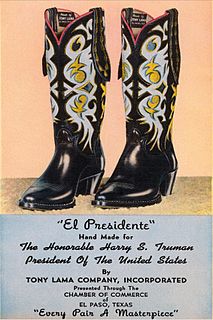
A boot, plural boots, is a type of footwear. Most boots mainly cover the foot and the ankle, while some also cover some part of the lower calf. Some boots extend up the leg, sometimes as far as the knee or even the hip. Most boots have a heel that is clearly distinguishable from the rest of the sole, even if the two are made of one piece. Traditionally made of leather or rubber, modern boots are made from a variety of materials. Boots are worn both for their functionality – protecting the foot and leg from water, extreme cold, mud or hazards or providing additional ankle support for strenuous activities with added traction requirements, or may have hobnails on their undersides to protect against wear and to get better grip; and for reasons of style and fashion.
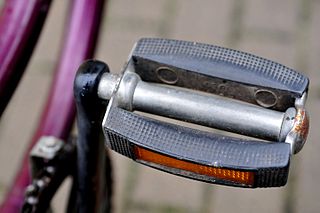
The pedal is the part of a bicycle that the rider pushes with their foot to propel the vehicle. It provides the connection between the cyclist's foot or shoe and the crank allowing the leg to turn the bottom bracket spindle and propel the bicycle's wheels. A pedal usually consists of a spindle that threads into the end of the crank, and a body on which the foot rest is attached, that is free to rotate on bearings with respect to the spindle.

Clogs are a type of footwear made in part or completely from wood. Clogs are used worldwide and although the form may vary by culture, within a culture the form often remained unchanged for centuries.

Slippers are light footwear that are easy to put on and off and are intended to be worn indoors, particularly at home. They provide comfort and protection for the feet when walking indoors.

Flip-flops are a type of sandal, typically worn as a form of casual wear. They consist of a flat sole held loosely on the foot by a Y-shaped strap known as a toe thong that passes between the first and second toes and around both sides of the foot or can be a hard base with a strap across all the toes.

Thigh-high boots, known also as thigh-length boots or simply thigh boots, are boots that extend above the knees to at least mid-thigh. Other terms for this footwear include over-the-knee boots and, especially when cuffed, pirate boots. Lengths vary from reaching just over the knee to reaching almost to the crotch.

Sandals are an open type of footwear, consisting of a sole held to the wearer's foot by straps going over the instep and around the ankle. Sandals can also have a heel. While the distinction between sandals and other types of footwear can sometimes be blurry, the common understanding is that a sandal leaves all or most of the foot exposed. People may choose to wear sandals for several reasons, among them comfort in warm weather, economy, and as a fashion choice.

Shoemaking is the process of making footwear.

A pedalboard is a keyboard played with the feet that is usually used to produce the low-pitched bass line of a piece of music. A pedalboard has long, narrow lever-style keys laid out in the same semitone scalar pattern as a manual keyboard, with longer keys for C, D, E, F, G, A and B, and shorter, raised keys for C♯, D♯, F♯, G♯ and A♯. Training in pedal technique is part of standard organ pedagogy in church music and art music.
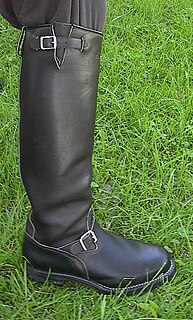
Motorcycle boots are associated with motorcycle riders and range from above ankle to below knee boots. They have an outside of a typical boot but a low heel to control the motorcycle. To improve motorcycle safety, motorcycle boots are generally made from a thick, heavy leather and may include energy absorbing and load spreading padding, metal, plastic and/or composite materials to protect the motorcycle rider's feet, ankles and legs in an accident. For use in wet weather, some boots have a waterproof membrane lining such as Gore-Tex or SympaTex.

A manual is a musical keyboard designed to be played with the hands, on an instrument such as a pipe organ, harpsichord, clavichord, electronic organ, melodica, or synthesizer. The term "manual" is used with regard to any hand keyboard on these instruments to distinguish it from the pedalboard, which is a keyboard that the organist plays with their feet. It is proper to use "manual" rather than "keyboard", then, when referring to the hand keyboards on any instrument that has a pedalboard.
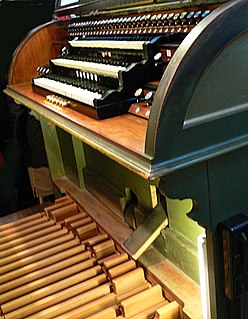
An expression pedal is an important control found on many musical instruments including organs, electronic keyboards and pedal steel guitar. The musician uses the pedal to control different aspects of the sound, commonly volume. Separate expression pedals can often be added to a guitar amplifier or effects unit and used to control many different aspects of the tone.

Cycling shoes are shoes purpose-built for cycling. There are a variety of designs depending on the type and intensity of the cycling for which they are intended. Key features include rigidity, for more-efficient transfer of power from the cyclist to the pedals, weight, a method of attaching the shoe firmly to the pedal and adaptability for use on and off the bicycle. Most high-performance cycling shoes can be adjusted while in use, via a quick-adjusting system that has largely replaced laces.

A ballet shoe, or ballet slipper, is a lightweight shoe designed specifically for ballet dancing. It may be made from soft leather, canvas, or satin, and has flexible, thin full or split soles. Traditionally, women wear pink shoes and men wear white or black shoes. Skin colored slippers—which are unobtrusive and thus give the appearance of dancing barefoot—are worn in modern ballets and sometimes modern dancing by both men and women.

A dress shoe is a shoe to be worn at smart casual or more formal events. A dress shoe is typically contrasted to an athletic shoe.

Cleats or studs are protrusions on the sole of a shoe or on an external attachment to a shoe that provide additional traction on a soft or slippery surface. They can be conical or blade-like in shape and can be made of plastic, rubber or metal. The type worn depends on the environment of play: grass, ice, artificial turf, or other grounds.

Boat shoes are typically canvas or leather with non-marking rubber soles designed for use on a boat. A siping pattern is cut into the soles to provide grip on a wet deck; the leather construction, along with the application of oil, is designed to repel water; and the stitching is highly durable. Boat shoes are traditionally worn without socks.
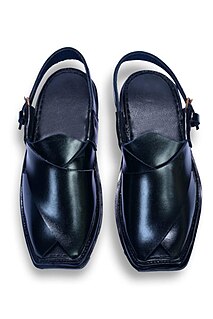
The Peshawari chappal is a traditional type of footwear of Pashtuns, worn especially by Pashtuns in the Khyber Pakhtunkhwa region. The shoe takes its name from the city of Peshawar, where it originates. While chappal is the word for flip-flops or sandals in Urdu, locals in Peshawar call the Peshawari Tasaply. The shoes are worn by men casually or formally, usually with the shalwar kameez. Because of their comfort, they are worn in place of sandals or slippers in Pakistan.





















